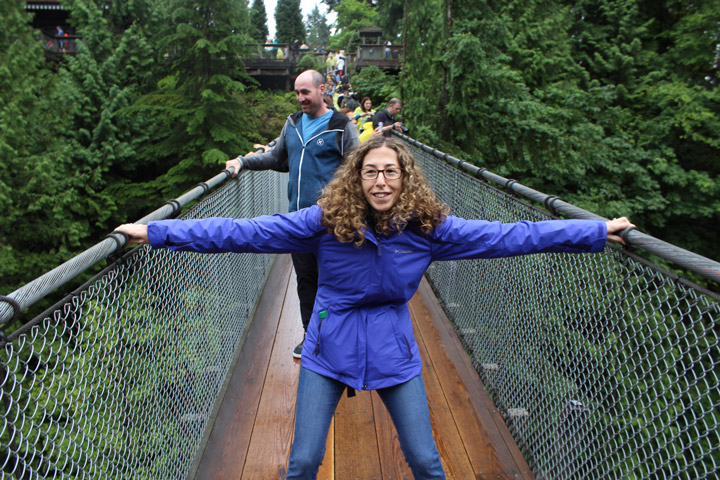Chris & Allyson vs. Alaska (2016)
Chapter One: Vancouver and Boarding
Alaska is a ridiculous place.
Thousands of years ago, men crossed the ice-choked Bering Strait to explore a new land. Confronted by harsh terrain, brutal cold and terrifying fauna, most proceeded to the beautiful San Fernando Valley, or the beach resorts of Mexico.
But a ridiculous few stayed. They endured inhuman winters, and scarcity fueled their ingenuity. Every plant became a banquet; every carcass became a hardware store. The men could not flourish, as the cruel realm would not allow it. But they survived. Man and nature began an elegant dance that would last centuries.
Then white people showed up, gave those original men diseases and crushed their way of life. This took about 20 years, give or take a few.
The white people were also ridiculous, leaving behind comfortable homelands to have their spirits reshaped on the anvil of Alaska. Some sought the tops of mountains. Some sought gold. Some sought fishing grounds, to provide crab buffets for those who sought cruise vacations. In the decades that followed, white men also sought oil, and starring roles in Alaska-based reality television shows.
The white people achieved many things, but they did not tame Alaska. The place is too ridiculous. Today, visitors are surrounded by beauty. They are also surrounded by a land that is constantly trying to kill them and will surely succeed if they stay too long.
Fortunately, in the 21st century, two weeks isn't too long. So ridiculous white people can happily vacation there, and report back.
Welcome to Vancouver
The first visitors to Alaska supposedly came from Eurasia, trudging across a sheet of ice.
Why would they make such a journey? Probably to avoid creditors.
Today, many visitors make an equally riveting journey, entering Alaska from Canada. The only ice involved is in their Long Island Iced Tea, which was prepared by a cruise ship bartender. The cruise ships leave from British Columbia, so on a Thursday in July 2016, Allyson Jaffe and I woke up at 3 a.m. to fly to Vancouver.
We made the journey because we desperately needed to relax. 2015 was a year without vacation. Yes, there were long weekends here and there, but never a full week off. Failure to take a proper vacation in 2016 would almost certainly violate the Geneva Conventions. Alaska would be a new experience for both of us, the cell phone service would apparently be terrible, and it was far enough away to justify a two-week trip.
Also, Alaska has animals. I enjoy a good animal encounter as much as the next guy. But Allyson enjoys animal encounters more than life itself. I've seen photos of our wedding, and I've seen photos of Allyson looking at bears. I am not under the illusion that our wedding was the happiest moment of her life.
But back to Canada!
You've probably heard about Vancouver from your friend who loves pot. It's one of Canada's most exciting cities. While it lacks the enormous shopping mall of Edmonton or the annual cattle roundup of Calgary, it does have 2 million people, breathtaking coastal scenery, ethnically diverse neighborhoods, and a lot of pot. We were only staying one night, and we don't smoke pot. But we decided to enjoy as much of the city as we could.
Our base of operations was the Westin Bayshore. Allyson enjoys nice hotels despite the cost. I enjoy nice hotels and the chance to complain about the cost. We were therefore both pleased with the Bayshore. Situated on the sea wall in downtown Vancouver, it offers convenient access to anything a traveling couple could want -- even animals. After checking in and dropping our bags, we had lunch nearby. Returning to hotel, we looked out our eighth-story window at the heated outdoor pool below. And inside that pool was a harbor seal. This seemed like a good omen. Were we swimming in the heated pool, the encounter would have been a terrifying nightmare of furious, slimy blubber. From the eighth floor, it was cute, and it immediately made our entire vacation a success.
But why rest on your laurels? Vancouver is a city connected to the outdoors; when people smoke so much pot, they need green spaces to assist them in communicating with the universe. One of the finest green spaces in Vancouver is named Stanley Park (for the Stanley of "Stanley Cup" fame). It's right next to the Westin Bayshore. That day, there were gray skies over the green space, but Allyson was prepared.
This was a big deal. My wife is a resilient woman who gracefully deals with tremendous stress at her job. However, she is also a woman who brings a sweater when it's 95 degrees outside. She is not great at handling nature, and the weeks leading up to our vacation featured an online shopping spree for weather gear. She was ready. If it started raining frogs, Allyson wouldn't have run for cover; she would have enjoyed it as the chance to see more animals.
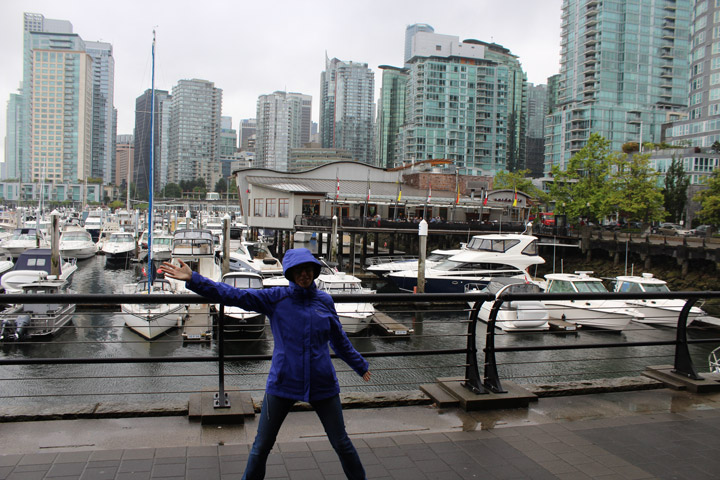
Vancouver's waterfront on a typically rainy day.

Looking out at the Lions Gate Bridge from Stanley Park.
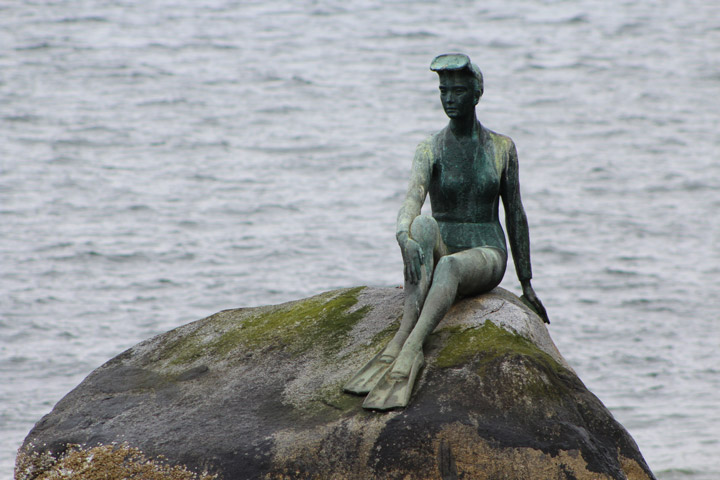
Stanley Park's derivatve (but fun) Girl in the Wetsuit.
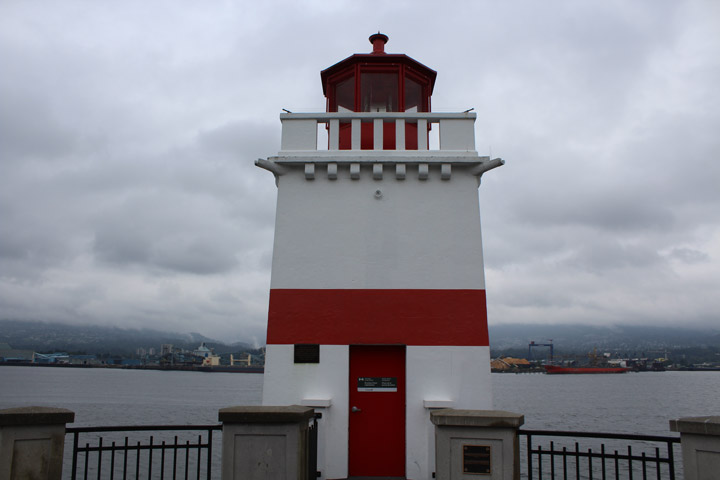
The Brockton Point Lighthouse, protecting Vancouver harbor.
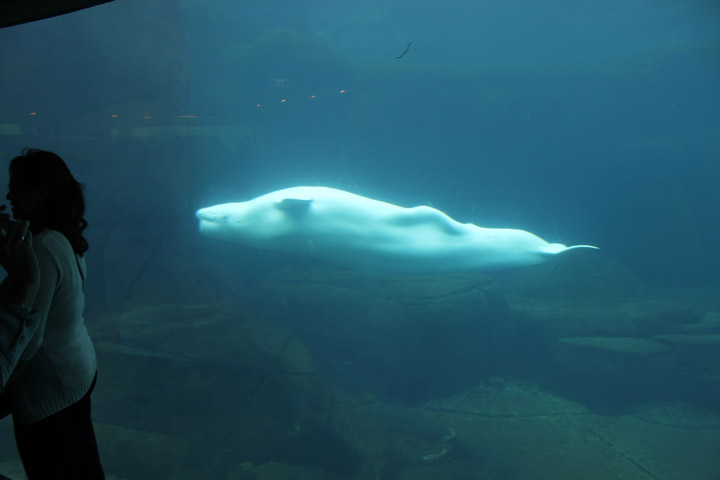
A beluga whale at the Vancouver Aquarium.

Getting up close with frog friends at the aquarium.

The Vancouver skyline, spotted from Stanley Park.
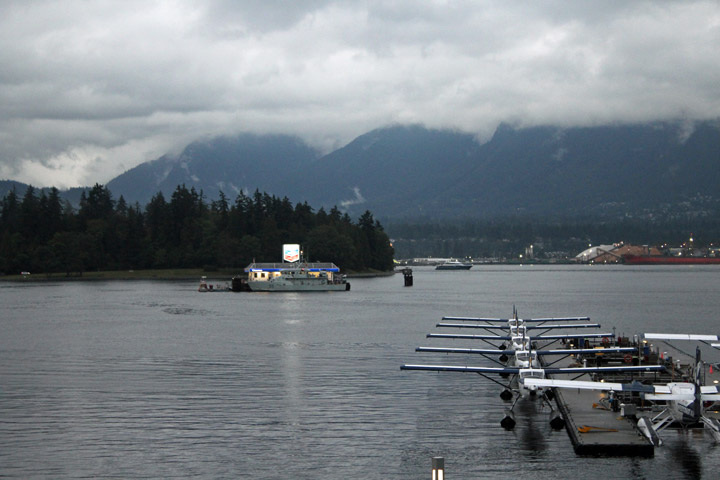
Sea planes, and their gas station, near the heart of Vancouver's waterfront.
We set off on foot to see what Stanley Park had to offer. The park occupies the tip of a peninsula that defines the entrance to Vancouver Harbor. The perimeter is maybe 6 or 7 miles long, and the highest point is 300 feet -- so parts of the park feature stunning cliffs, and most of it is on a slope. Lesser cities would call that a great park and leave well enough alone. Vancouver decided to put all its eggs in one basket. Stanley Park features:
Hiking. There are miles of footpaths, both along the water and through the woods. There are also miles of rollerblading lanes, although we saw no rollerbladers. There's a good chance that someone on the Vancouver City Council was REALLY into rollerblading and held up the city budget until they gave him a win.
Great views of the water. Perhaps the finest view is on the harbor side of the peninsula, looking out at the Lions Gate Bridge that connects Stanley Park to North Vancouver. There's a "beach" there, which appears and disappears with the very active tides. We were there at low tide, so I was able to gleefully scramble over slime-covered smelly rocks while Allyson let me. As a bonus, we watched the birds of Stanley Park -- in this case gulls and ravens -- smashing shellfish open by dropping them against the slime-covered smelly rocks. This was technically our second animal encounter. Remember, not all of god's creatures are cute.
Intriguing statuary. Vancouverites (Vancouvians? Vancouverettes?) have a place in their heart for the "Girl in the Wetsuit," a clear rip-off of the Little Mermaid statue in Copenhagen. The girl is sitting on a particularly large slime-covered smelly rock. At low tide, she seems like an accomplished rock scrambler. At high tide she seems stranded. It's adorable. There's also a pavilion with a bunch of totem poles. If you visit the Pacific Northwest, you will see a lot of these. Judging from Stanley Park, the appropriate response is to get off your tour bus, take a picture, and vow to reflect on their spiritual significance at some point down the line.
A rose garden. Which was nice, but not so nice as to linger there in the rain.
The Brockton Point Lighthouse and the 9 O'Clock Gun. These relics hark to a bygone maritime era, when setting sail meant guaranteed adventures, venereal diseases and almost certain death. The modest lighthouse helped many a navigator find his way through the busy waters of Vancouver Harbor. The 9 O'Clock Gun was (and still is!) fired at 9 p.m. each day. In olden times, this helped vessels accurately set their chronometers. Today, it makes visitors almost choke on their late dinners, thinking that something in the harbor just exploded.
All these things were lovely, but they were a mere prelude to the crown jewel of Stanley Park: the Vancouver Aquarium. Our hope for this vacation was to see animals in the wild, but when you're spending thousands of dollars for two weeks away from home, it's never bad to hedge your bets.
The Vancouver Aquarium is an excellent facility, with everything you expect: Fish from around the world, marine life indigenous to the region, an impressive selection of souvenir magnets, and enough school-age children to make you wish for some kind of shark-feeding accident. It also has an outdoor section, which is kind of like seeing animals in the wild if you frame the photos carefully enough. Forty years down the line, you'll remember it as the wild.
Two creatures stood out. "False killer whales" live in the shadows of two other species. First, as their name clearly implies, they aren't quite killer whales -- and that clearly is a source of disappointment. Second, neither killer whales nor false killer whales are ... well, whales. They are in fact very large varieties of dolphin. It would be more accurate to call orcas "killer false whales," and false killer whales "false killer false whales." They have a FKFW at the Vancouver aquarium, and he's predictably moody and mysterious. You would be emo too, if your entire species was built on a series of lies.
The second standout was the beluga whale, a mysterious and milky white beast. It looks like a glop of mashed potatoes was shellacked in glue, then learned to swim with an absurd amount of grace. It reminded me of myself, when I swim without a t-shirt. Only, you know, graceful.
After the aquarium, we walked back to the hotel and relaxed for a moment; you should definitely catch your breath after accomplishing every goal of your two-week vacation within the first four hours. And then you should celebrate!
Gastown is the oldest neighborhood in Vancouver, and according to the city's tourism website it "grew from a single tavern founded by John ‘Gassy Jack’ Deighton back in 1867." Speculate wildly about why they called him "Gassy Jack," as your answer will probably be far more entertaining than the truth. Today, Gastown has a lot of restaurants and a lot of shops. It also has the virtue of being one mile from the Westin Bayshore, so when our concierge recommended a Gastown restaurant we decided to walk. The path was along the harbor, past all kinds of harbor-ish things -- the cruise ship dock, a sea plane terminal, and a weird house on stilts.
Our stroll through the drizzle eventually brought us to The Flying Pig, where we shared a communal dining table with a few 20something Asian girls. They weren't all that interested in hearing me wax poetic about beluga whales, so it was mostly a celebration between Allyson and me. On our way back to the hotel, we poked our noses in any souvenir shop that had a decent-sized bear statue near the entrance. Which is to say, we stopped in every souvenir shop we passed.
According to a Chinese saying, "a journey of a thousand miles begins with a single step." As planned, our journey would be around 7,000 miles, and it actually began several months before with a series of non-refundable deposits. But the metaphorical "first step" had been a good one, and with our feet planted firmly on Canada's face, we were excited to push farther north.
Days Two and Three: More Vancouver, and Boarding the Millennium
It's fun to jog in other countries, to see how their fitness enthusiasts match up with the bat**** crazy exercise freaks at home. Do Canadians run with their arms totally straight? Are they all wearing leggings festooned with maple leaf designs? Do they INSIST on referring to distances using the metric system, or are they decent human beings?
On day two of our vacation, I got up at 6 a.m. to find out. The Westin has a great program whereby you call the front desk and tell them all your relevant dimensions. Then they have someone deliver socks, sneakers, shorts and a workout shirt to your room. After you're done, they charge you only $5, provided you leave all the sweaty, bacteria-ridden items somewhere in the room. This way, you can enjoy a brisk workout in the middle of your journey, without making the rest of the clothes in your suitcase smell like wet garbage on a summer day. Suited up in my rental gear, I hit the footpaths around the perimeter of Stanley Park. (Allyson slept in, to see if dreams are significantly different in Canada. Do they feature more bears? Are there more white people? She hasn't shared her conclusions with me.)
Canadians, as it turns out, jog roughly like Americans. You'd think that fleeing bears all day would make them faster, but I couldn't tell the difference. Stanley Park, however, is one of the most glorious jogging locations imaginable. The perimeter loop takes you past some extremely scenic waterfront, flanked by 100-foot rock cliffs in places. There's even a 60-foot rock spire, just off the shore, with a story: According to the Natives, a man was transformed into the rock by the gods, as a reward for his unselfishness. It's a wonderful reminder to be more selfish. The trail eventually passes under the Lions Gate Bridge, and it was easy to see a huge difference in the tide from the day before. The slime-rock beaches were now shallow waters filled with slimy rocks. Breathtaking stuff.
Back at the hotel, Allyson and I enjoyed breakfast in the hotel restaurant and planned the day. (I had scrambled egg and salmon tacos, the official breakfast of NAFTA.) There was a cruise ship waiting for us, and the cruise companies want you on board by a certain time. They do not mess around: If you are late, they will abandon you, faster than a "Maury" guest cleared by a paternity test. Also, before boarding the first time, you have to do some paperwork, put your home up for collateral, give a few tissue samples, swear a loyalty oath and undergo the ritual branding.
Vacation is supposed to be about adventure, though, so we decided to squeeze in a little more Vancouver. The concierge assured us that we could TOTALLY see the Capilano Suspension Bridge in time, so we stashed our bags and hopped in a cab.

Taking the long, scary entrance to Capilano Suspension Bridge Park.

The misty forests of Capilano park.
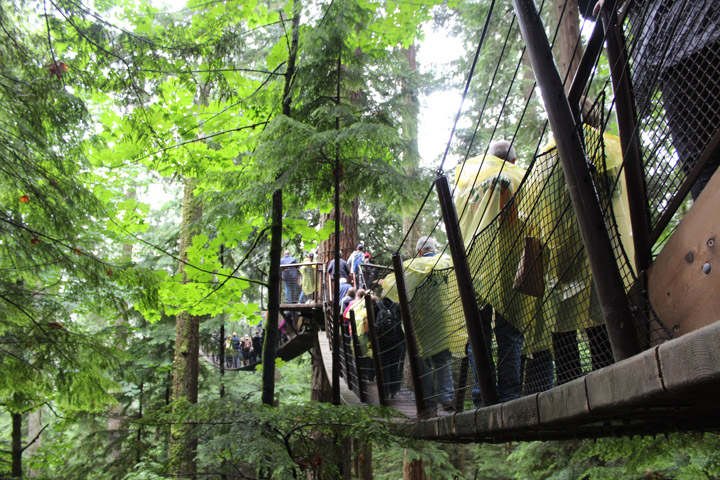
The Ewok village for tourists, at Capilano park.
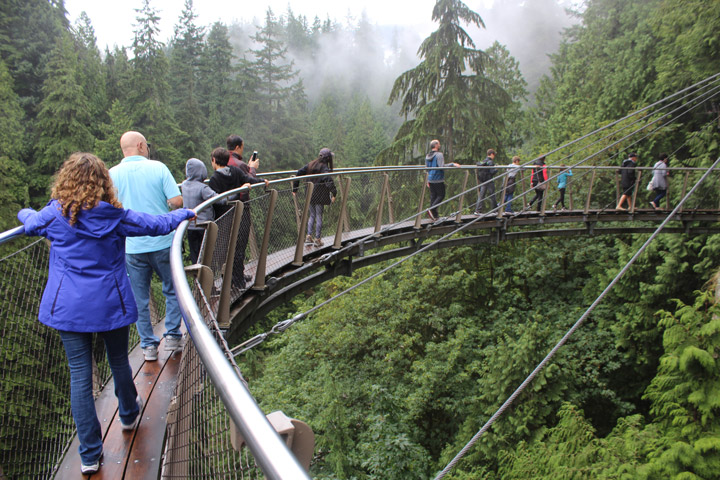
One the skywalks giving you a different view of the forest.
It goes without saying that America has the BEST tourist traps. Our country has both Mystery Spots and Mystery Holes, proving that we didn't waste all the nation's ingenuity on the moon landing. But Canada is no slouch. In the 1880s, an engineer bought 6,000 acres of land along the Capilano River and strung a nifty little bridge across the canyon. (The modern version is 230 feet above the canyon floor and 450 feet long.) The various owners eventually realized that they could make a lot of money by charging people to walk across the bridge, for there is something in the human spirit that enjoys the vague threat of falling to your death.
In 2016, the Capilano Suspension Bridge Park is a very slick operation working in total synchronicity with the tourism industry. Meaning, it costs $40 to get in and it is usually overrun by Asian people with cameras by about 10 a.m. But it's still a good time.
It was drizzling when the cab dropped us off in North Vancouver. Tte park thoughtfully provides ponchos of the finest quality, but even fine-quality ponchos make you look like a sentient garbage bag. So we went with our regular coats. Crossing the bridge is a bit of a thrill, because it holds hundreds of people at a time and has a lot of give. It's the 21st century, so every person also stops every four feet to take a picture of themselves. (Allyson and I included.) So if you ever visit, block out at least 2.5 hours to actually walk the full 450 feet.
Once you're across, there's a lot more to see. The property has been improved over the years with a nice boardwalk, letting you stroll among the mighty trees of the Pacific Northwest. More recently, they put in an Ewok-style boardwalk that allows you to stroll near the tops of the mighty trees of the Pacific Northwest. And when you're done that, there's a THIRD boardwalk that lets you stroll on the side of a cliff, high above the canyon floor. If you believe in engineering, this is the park for you. If you're afraid of heights and think physics is a scam perpetrated by the Devil, you might want to hang out at the very nice gift shop near the entrance.
The park isn't particularly remote, but it gives you some glimpses of the forest ecosystem at work. There are slugs, and birds, and fish-filled ponds. There are also Asian tourists in the trees, carefully coordinating with Asian tourists on the ground to capture hundreds more camera angles than inferior American tourists. It is a symbiotic miracle of nature.
Allyson and I agreed that this had been a good call, and we caught a shuttle bus back to the Westin with plenty of time to spare. When we made it to the cruise dock and saw that there was no line, we agreed that it had been a great call. All the paperwork was knocked out in short order, ID cards were issued, and in mere minutes we boarded the Celebrity Millennium.
It says something about the modern age that our heads don't automatically explode at the notion of cruise ships. The explorers who "discovered" America set sail in pathetically small vessels that were filled to the brim with smelly people and disgusting provisions. The swimming pool of a modern cruise ship might be big enough to float one of those vessels. The Millennium is more than 900 feet long and 100 feet across; it can carry more than 2,100 passengers and another 1,000 crew. As cruise ships go, it's on the small side. It only has the one casino.
Our little piece of the boat was the strategically chosen cabin 9102. It was mid-ship, next to the one amenity no one uses: the library. It was also on the starboard side of the ship, which matters. We were travelling north, which is "up" on the map. That means Alaska was going to be on the right. If you're paying for a nice little private balcony, you want to have a view of something.
As rooms go, the cabin was perfectly fine. It had a decent bed, a tiny bathroom, and lots and lots of mirrors. This is a cruise ship trick -- mirrors create the illusion that any space is much bigger, so they put one on every feasible surface. (There were mirrors on the ceilings of the long corridors running the length of the ship.) The added benefit of cruise ship mirrors is that you have constant views of your aging, wrinkled skin, which makes you far more likely to spring for a $300 spa treatment at some point during the voyage.
The rest of the afternoon was spent getting to know our boat. Allyson had arranged for some kind of special status upgrade. (Cruise ships are all about bringing people together, and then finding ways to financially separate yourself from the riff raff.) The upgrade gave us access to an exclusive dining room, known as Blu; it had much cozier seating than the main dining room. We scoped it out.
Then we did the ship-wide muster drill, where people completely ignore instructions for when the boat sinks. Our muster point was the casino, and during the drill we spent a few minutes talking to Sherrie and Evan from Alabama. They were heading to a friend's wedding in Seward, and they were away from their kids. After the drill, we checked out the gym, and the theater, and the outdoor pool areas that no one would be using because, oh yeah, we were going to Alaska.
The boat shoved off in the late afternoon, and we stood on deck as the ship passed under the Lions Gate Bridge. Vancouver was now officially behind us.

On board the Millennium and ready to set sail.
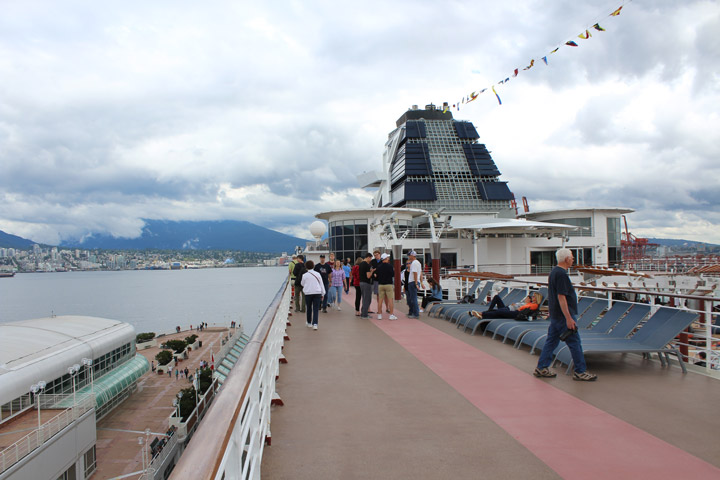
The upper deck of the Millennium, foro brisk walks in brisk weather.

Our "exclusive" dining room for the week.

Ready to pass under the Lions Gate -- and head for the Inside Passage.

Not much sunning on an Alaska cruise, but just in case ...
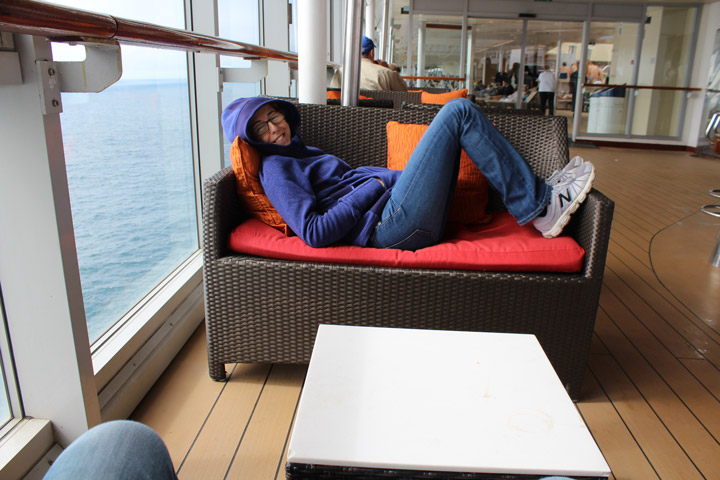
Finding an indoor way to lounge.
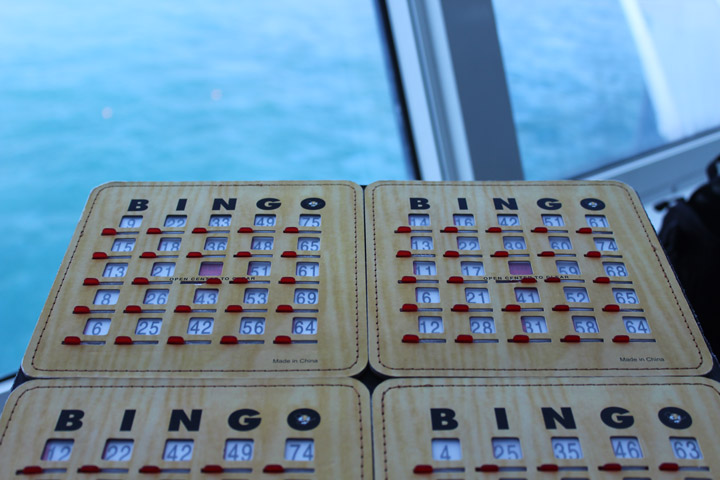
If you've never taken a cruise, this is what you're missing.
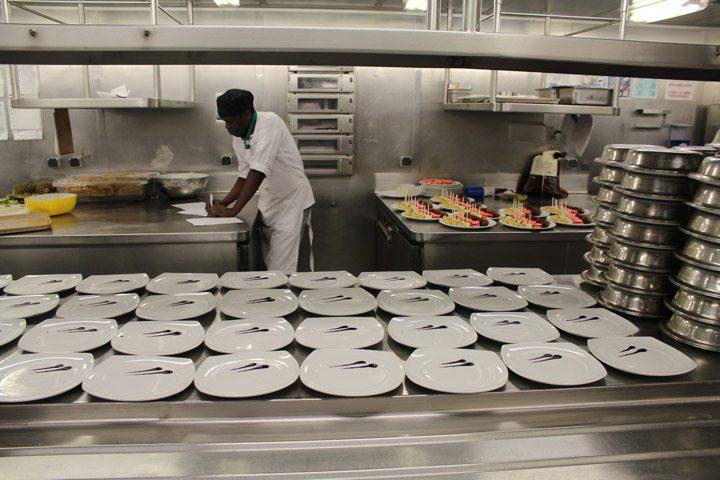
Chefs get dessert ready as passengers tour the impressive galley.
We had dinner at Blu, where the tables are close enough to invite conversation with other guests. It's easy to talk with strangers on a cruise ship, because they've probably been drinking, and you always have this icebreaker: "CAN YOU BELIEVE THIS F***** SHIP?" We ended up chatting with Larry and Karen from Southern California. They were dedicated cruisers, as Larry was a retired IT executive.
After dinner, we took in a brief presentation on wildlife in the ship's theater, then watched about five minutes of comedian Dave Burleigh. Dave wasn't exactly bad, but we work in a comedy club, so it didn't feel like vacation to watch him.
The next day was more of the same. The Millennium was headed north toward the American border and the "Inside Passage." That sheltered nautical route winds along the islands near the Pacific coastline. However, it was going to take a day to get there. Cruise ships can max out at around 150 mph (I’m guessing), but in the interests of safety and comfort, sissy cruise ship captains are reluctant to go full throttle. That’s why most cruises feature days where all you do is cruise. On Carnival ships, they call them "fun days at sea," because "drunk days at sea" is a little bit on the nose. They're good days to hit the gym, enjoy the spa, catch up on your reading, or eat your weight in buffet food.
We woke up at 8 a.m. and enjoyed the sight of some marine mammals playing in the ship's wake, just below our balcony. They were probably porpoises. Off in the distance, we saw the spouts of a humpback whale.
This was very exciting. But be forewarned. No matter what animals you see on an Alaskan cruise -- and no matter how long you spend staring at the water -- someone on board will have a better story when you're chatting at the end of the day. If you see porpoises and one whale, the people at the dinner table next to you will be chatting about the orca that jumped 100 feet straight out of the ocean right next to their cabin, did a full somersault and winked at them before landing in the exact center of a ring of assorted sea mammals engaged in choreographed water ballet. Just enjoy what you do see and try not to be jealous.
We enjoyed a few adult beverages during the day – but not too many. Alaskan cruises are active, with port excursions that are far more enjoyable if you're not perpetually on the verge of throwing up. It's better to not be drunk all the time, so we did not get a "drink package," instead choosing to pay for beverages a la carte. This was also a good math decision, as the only way to "save money" with a drink package is to have eight or nine drinks a day, every day. This does not stop most people on board from getting a drink package, and the ship's crew is trained to ask you repeatedly why you didn't buy a drink package, in a tone that suggests you might not be mentally competent enough to dress yourself. But if you're willing to be a little bit of a pariah, it's definitely the way to go.
We enjoyed a galley tour. You can't live on a cruise ship for a week and NOT wonder about the logistics (unless you are really devoting all your time to saving money with that drink package). The Millennium has facilities to feed 3,000 people multiple times a day. And most of the food is not, by any objective standard, bad. After sitting through a gussied-up sales pitch for the on-board restaurants that cost extra money, we participated in a group tour of the main kitchen, where the sausage is literally made. Or at the very least, removed from sausage storage containers and cooked.
At Allyson’s urging, we played a little Bingo. It's not just for old people with no skill! All you need is a pulse and about $40 to rent two bingo cards. It was a great thrill as the very entertaining Mexican cruise director (who for some reason was a huge Philadelphia Eagles fan) helped us win no money whatsoever.
With the gambling bug now infecting both of us, we closed out the day with a post-dinner trip to the ship's casino. The main motivation was to check out a gambling machine called "Kitty Glitter." There's no way to improve on that fact with a joke, so I will simply report that it is a terrible video slot machine.
And at some point while we were sleeping off the day's excitement, we crossed over the American border to enter Alaska for the first time. At that exact moment, four humpback whales did simultaneous breaches while singing The Star-Spangled Banner. We missed it, as we were sleeping, but I'm sure the people next to us at breakfast the next morning saw it.
